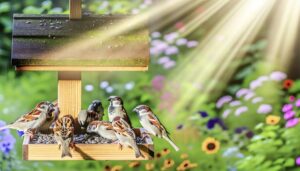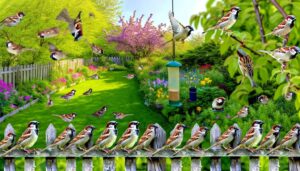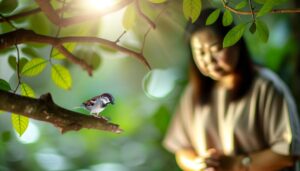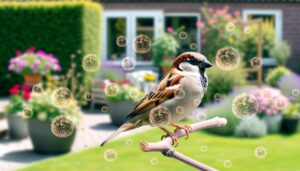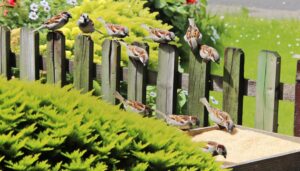5 Tips to Get Rid of House Sparrows from Your Feeders
To mitigate house sparrows at feeders, employ tube feeders with small perches or caged feeders to limit sparrow access. Avoid using millet and cracked corn, opting instead for safflower or nyjer seeds, which are less attractive to sparrows.
Place feeders away from dense vegetation and frequently reposition them to disrupt habitual visits. Use protective netting or barriers with appropriately sized mesh to exclude sparrows while allowing native birds to feed.
Implement scare tactics such as predator decoys and reflective objects to enhance deterrence. Regular monitoring and maintenance of feeders are essential for effective control.
Additional strategies offer further refinement.
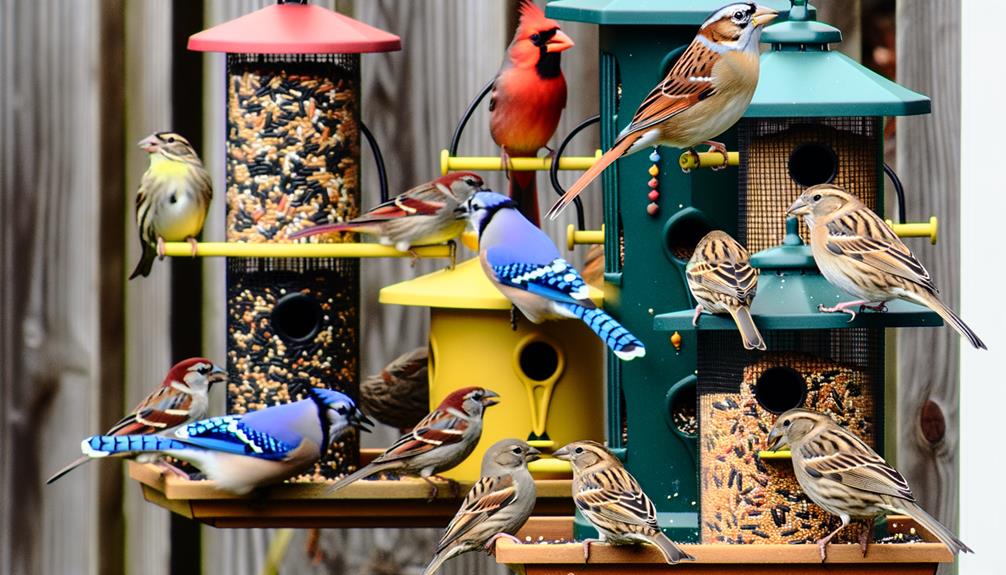
Key Takeaways
- Use tube feeders with small perches to prevent house sparrows from accessing the food.
- Offer safflower or nyjer seeds, which are less attractive to house sparrows.
- Place feeders away from dense vegetation and frequently reposition them to disrupt sparrow habits.
- Install caged feeders or weighted perch feeders that selectively allow smaller or lighter birds.
- Implement physical barriers like wire mesh or dome barriers to restrict sparrow access.
Identify House Sparrows
House Sparrows (Passer domesticus) can be identified by their distinctive plumage, which includes a gray crown, black bib, and chestnut nape in males, and a more subdued brown and gray coloration in females. These morphological characteristics aid in accurate identification, essential for effective management strategies.
Additionally, their robust, conical beak is adapted for seed consumption, distinguishing them from other passerine birds. Behavioral patterns further assist in identification; House Sparrows are gregarious, often seen in large flocks and exhibiting aggressive behavior at feeders.
Their vocalizations, characterized by a series of chirps and cheeps, are another identifying feature. Understanding these specific traits is vital for bird enthusiasts and researchers aiming to mitigate the impact of House Sparrows on native bird populations.
Use Sparrow-Resistant Feeders
Identifying House Sparrows is the first step, but implementing sparrow-resistant feeders is a strategic approach to effectively managing their presence at bird feeders. Sparrow-resistant feeders are designed to selectively exclude these invasive birds, promoting a balanced ecosystem.
There are several evidence-based feeder designs that have proven efficacy:
- Tube Feeders with Small Perches: These feeders have perches that are too small for House Sparrows, favoring smaller species.
- Upside-Down Feeders: These feeders require birds to feed while hanging upside down, a position that House Sparrows find challenging.
- Weighted Perch Feeders: These feeders close access ports when heavier birds, such as House Sparrows, land.
- Caged Feeders: These feeders encase the birdseed in a cage with openings too small for larger birds, effectively excluding House Sparrows.
Adjust Feeder Placement
Strategically adjusting the placement of bird feeders can greatly reduce the prevalence of House Sparrows, thereby fostering a more diverse avian community. Research indicates that relocating feeders away from dense foliage or structures can deter these invasive birds. House Sparrows prefer environments with ample shelter, hence open areas are less appealing to them. Additionally, raising feeders to a higher elevation or placing them in remote locations can limit House Sparrow access while still attracting desired species.
| Placement Strategy | Expected Impact |
|---|---|
| Away from dense vegetation | Reduced House Sparrow presence |
| Elevated positions | Decreased House Sparrow access |
| Isolated locations | Increased diversity of species |
| Near natural food sources | Enhanced attraction for natives |
| Frequent repositioning | Disrupts House Sparrow habits |
These strategies are supported by avian behavioral studies, highlighting their effectiveness in promoting a balanced ecosystem.
Offer Safflower Seeds
Another effective method to deter House Sparrows while attracting more desirable species is to offer safflower seeds, which are less appealing to these invasive birds. Safflower seeds are characterized by their unique composition and taste, making them a strategic choice for bird enthusiasts. Research indicates that House Sparrows show minimal interest in safflower seeds, while species such as Northern Cardinals and Chickadees find them quite palatable.
The following benefits can be observed:
- Selective Attraction: Targets preferred species like cardinals and finches.
- Reduced Waste: Less spillage as fewer sparrows consume the seeds.
- Nutritional Advantage: High in protein and fat, promoting avian health.
- Cost-Effective: Minimizes expenditure on less effective seed types.
Implementing safflower seeds can optimize feeder dynamics to a considerable extent.
Avoid Millet and Cracked Corn
House Sparrows are particularly attracted to millet and cracked corn, making these seeds counterproductive for those aiming to discourage their presence at bird feeders. Empirical studies indicate that Passer domesticus, commonly known as House Sparrows, exhibit a strong preference for these food sources due to their nutritional content and ease of consumption.
To minimize House Sparrow activity, it is advisable to eliminate millet and cracked corn from bird feeder offerings. Instead, opt for seeds less appealing to House Sparrows, such as safflower or nyjer seeds. This strategic adjustment aligns with ornithological recommendations and aids in fostering a more balanced avian ecosystem.
Install Nesting Boxes for Native Birds
Installing nesting boxes specifically designed for native bird species can effectively encourage their habitation while reducing the dominance of invasive House Sparrows. This approach leverages the specific nesting preferences of native birds, thereby limiting suitable nesting sites for House Sparrows.
Key considerations include:
- Entrance Hole Size: Tailor the entrance dimensions to accommodate native species while excluding House Sparrows, typically using holes between 1 1/4 and 1 1/2 inches.
- Box Placement: Position boxes away from human activity and at appropriate heights to attract specific native species.
- Material Preference: Utilize untreated wood to mimic natural habitats, avoiding synthetic materials.
- Maintenance: Regularly clean and inspect boxes to prevent occupancy by House Sparrows and ensure optimum conditions for native birds.
Implementing these measures creates a favorable environment for native birds, enhancing biodiversity.
Use Netting and Barriers
To effectively mitigate the presence of house sparrows at feeders, the implementation of netting and physical barriers proves crucial. By installing protective netting and selecting appropriate mesh sizes, one can create an environment that selectively excludes house sparrows while allowing access to desired avian species.
Evidence suggests that physical barriers, when strategically positioned, can markedly reduce the prevalence of this invasive species at feeding sites.
Install Protective Netting
Implementing protective netting and barriers around bird feeders can effectively deter house sparrows by limiting their access while allowing desired bird species to feed undisturbed. This method utilizes physical exclusion principles to target specific avian behaviors and preferences. Evidence suggests that netting must be carefully chosen and installed to maximize effectiveness.
- Mesh Size: Use netting with a mesh size small enough to prevent sparrows from entering but large enough to allow smaller, preferred birds to pass through.
- Material Durability: Opt for UV-resistant, weatherproof materials to guarantee longevity and reduce maintenance.
- Installation Technique: Secure netting tightly around feeding areas to prevent sparrows from finding gaps or weaknesses.
- Regular Maintenance: Inspect and repair any damage promptly to uphold the barrier's integrity.
These measures guarantee effective sparrow exclusion while accommodating desired avian species.
Implement Physical Barriers
Physical barriers, such as netting and specific structural modifications, serve as a scientifically validated method to exclude house sparrows from accessing bird feeders. By implementing physical obstructions, it is possible to target the entry points of house sparrows effectively. Structural modifications can include altering feeder designs to make them less accessible to larger birds. Evidence supports that such barriers reduce house sparrow presence while allowing smaller, desired species to feed uninterrupted.
| Barrier Type | Effectiveness | Target Species Excluded |
|---|---|---|
| Netting | High | House Sparrows |
| Wire Mesh | Moderate | Larger Birds |
| Dome Barriers | Variable | Squirrels, Larger Birds |
| Perch Modifications | Specific | House Sparrows |
| Entrance Restrictors | Targeted | House Sparrows |
Employing these barriers enhances selective feeding, essential for maintaining ecological balance at feeders.
Choose Specific Mesh Sizes
Selecting appropriate mesh sizes for netting and barriers is crucial to effectively exclude house sparrows while allowing access to desired bird species. Research indicates that an ideal mesh size can selectively permit the entry of smaller, non-invasive avian species and deter larger, more aggressive house sparrows.
Consider the following recommendations:
- Mesh Size: Utilize a mesh with openings of 1.5 inches (3.8 cm) or smaller to prevent house sparrows from accessing feeders.
- Material Durability: Employ sturdy materials such as galvanized steel or UV-resistant polyethylene to withstand various weather conditions.
- Installation Height: Position netting at a height that deters sparrows but remains accessible to smaller birds.
- Regular Maintenance: Inspect and maintain netting regularly to ensure it remains effective and free from damage.
These strategies improve feeder selectivity and reduce house sparrow presence.
Create a Sparrow-Free Zone
Establishing a sparrow-free zone necessitates the strategic placement of feeders designed to exclude house sparrows while accommodating desired avian species. Utilization of feeders with small openings or cages that selectively permit access to smaller, native birds can effectively mitigate sparrow interference.
Additionally, positioning feeders in less open, more sheltered environments reduces sparrow dominance, as these birds prefer open feeding areas. Employing nyjer seed, favored by finches but generally ignored by house sparrows, further contributes to a specialized feeding environment.
Empirical evidence supports that altering feeder height and employing weight-sensitive perches can deter sparrows, which are heavier than many native species. By implementing these methods, one can create an efficient sparrow-free zone that benefits targeted bird populations.
Implement Scare Tactics
To effectively deter house sparrows from feeders, employing scare tactics such as visual and auditory deterrents can prove to be a scientifically sound approach. These methods leverage house sparrows' natural aversion to sudden, unfamiliar stimuli, thereby reducing their presence around feeding areas.
The following scare tactics are efficacious:
- Predator Decoys: Utilize plastic owls or hawks to simulate the presence of natural predators.
- Reflective Objects: Install reflective tape or CDs to create visual disturbances that sparrows find unsettling.
- Auditory Deterrents: Implement devices emitting distress calls or predator sounds to discourage sparrows.
- Motion-Activated Sprinklers: Deploy sprinklers that activate upon detecting motion, startling sparrows and deterring them from feeders.
These methods collectively enhance the efficacy of sparrow deterrence strategies.
Monitor and Maintain Feeders
While scare tactics can effectively reduce house sparrow presence, it is equally important to consistently monitor and maintain feeders to further mitigate their impact.
Regular surveillance allows for early detection of house sparrow activity, enabling timely intervention.
Cleaning feeders frequently with a 10% bleach solution not only prevents disease transmission but also reduces residue that may attract house sparrows.
Additionally, adjusting feeder designs to accommodate desirable species, such as using smaller perches and mesh feeders, can deter house sparrows.
Strategic placement of feeders away from dense shrubbery and structures can minimize sparrow nesting opportunities.
Employing a combination of these methods creates an inhospitable environment for house sparrows while supporting the presence of preferred bird species.
Conclusion
Creating a sparrow-free feeding environment demands strategic implementation of various techniques. Consider the approach of a gardener who selectively prunes to promote a balanced ecosystem.
By identifying house sparrows, using sparrow-resistant feeders, adjusting feeder placement, offering safflower seeds, avoiding millet and cracked corn, employing netting and barriers, establishing a sparrow-free zone, and implementing scare tactics, a harmonious avian habitat can be maintained.
Consistent monitoring and maintenance of feeders is essential to guarantee long-term success in managing house sparrow populations.


